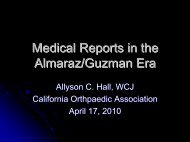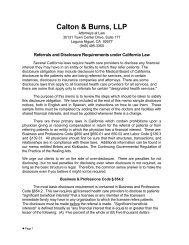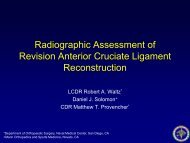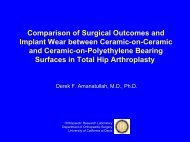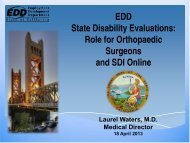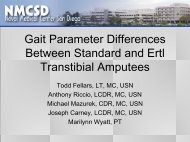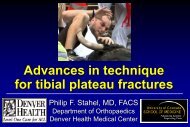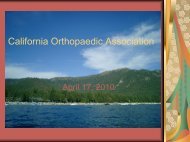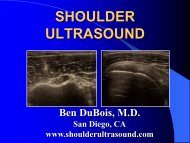Enhancing Your Practice's Revenue - California Orthopaedic ...
Enhancing Your Practice's Revenue - California Orthopaedic ...
Enhancing Your Practice's Revenue - California Orthopaedic ...
- No tags were found...
You also want an ePaper? Increase the reach of your titles
YUMPU automatically turns print PDFs into web optimized ePapers that Google loves.
(AANP) and American Academy of Physician Assistants(AAPA) websites both provide statistics in this regard;so does the Medical Group Management Association(MGMA). Generally speaking however, sources agree thatsalaries of NPs and PAs are not significantly different: themajority earn between $85,000 and $95,000 per year withvariations relating to experience, practice location, specialty(orthopaedics often pays more), and so forth. Incentiveand on-call pay may boost compensation by $5,000 to$10,000.Collections for NPs, according to the Medical GroupManagement Association (MGMA) average approximately$147,000 (median: $105,000). Collections for primary carePAs average $175,000 (median: $150,000); collections forsurgical PAs average $123,000 (median: $93,000). The reasonfor the difference between primary care PA collectionsand surgical PA collections is not immediately apparentespecially since surgical PAs’ mean charges were significantlygreater than those of primary care PAs ($648,000 vs.$357,000).Possibly primary care PAs function more autonomouslyor are able to collect more from third parties. Alternativelyor in addition, surgical PAs may perform a great deal ofwork that (a) cannot be billed; (b) isn’t billed even if it canbe; and/or (c) cannot be easily collected.Regardless, the advantages to orthopaedic surgeons ofNPEs such as NPs and PAs are clear. Even if the practicebreaks even in the sense that an NPE’s salary plus benefitsand overhead equals his or her collections, the existenceof this person frees up the orthopaedists to perform morehighly-compensated work.Athletic Trainers (ATs/ATCs)Athletic trainers (ATs) specialize in the prevention,diagnosis, assessment, treatment, and rehabilitation ofmuscle and bone injuries and illnesses. ATCs are ATs whohave been certified by the Board of Certification (BOC);see www.bocatc.org.ATs should not be confused with fitness trainers orpersonal trainers, who are not health¬care workers, butrather people who train other people to become physicallyfit. ATs try to prevent injuries by educating people on howto reduce their risk for injuries and by advising them on theproper use of equipment, exercises to improve balance andstrength, home exercises and therapy programs. They alsohelp apply protective or injury-preventive devices such astape, bandages, and braces.Athletic trainers may work under the direction oflicensed physicians and in collaboration with other healthcareproviders. The extent of the direction an AT receivesranges from discussing specific inju-ries and treatmentoptions with a physician to performing evalu¬ations andtreatments as directed by a physician.ATs held about 16,300 jobs in 2008 and are found inevery part of the country. AT jobs are typically re¬lated tosports, although an increasing number also work in othersettings. In 2008, 38% of athletic trainers worked in healthcare, including jobs in hospitals, offices of physicians, andoffices of other health practitioners. Most athletic trainerswork in full-time positions and typically receive a salaryplus benefits. The salary of an athletic trainer dependson experience and job responsibilities, and varies by jobsetting. The median annual wage for athletic trainers was$39,640 in May 2008. The middle 50 percent earned between$32,070 and $49,250. The lowest 10 percent earnedless than $23,450, while the top 10 percent earned morethan $60,960.Employment of athletic trainers is projected to grow37 percent from 2008 to 2018. This is much faster thanthe average for all occupations, because of their role inpre¬venting injuries and reducing healthcare costs. Jobgrowth will be concentrated in the healthcare industry,including hospitals and offices of health practitioners. Thedemand for health care, with an emphasis on preventivecare, should grow as the population ages and as a way tore¬duce healthcare costs. Increased licensure requirementsand regulation has led to a greater acceptance of athletictrainers as qualified healthcare providers. As a result, thirdpartyreim¬bursement is expected to continue to grow forathletic training services.Most third party payers only reimburse for “covered” (bythe plan) and “medically necessary” services. ATCs currentlyreceive reimbursement working in a variety of settings,including hospitals, physicians’ offices, sports rehabilitationclinics and college and university settings. Some ATCs havereceived reimbursement on 60% to 85% of billings. Somehave fared less favorably. Licensure is key to successfulreimbursement from third party payers. Direct reimbursementfor services notwithstanding, if a practice employsATs or ATCs, this can be an excellent marketing tool. ATsand ATCs may be the first contact a patient or his/her familyhas with the doctor or practice.Additional information on ATs and ATCs is available atwww.nata.org.Liability for non-physician ExtendersLawsuits against physician extenders are uncommon; mostcases name the supervising physician first. Settlementsthat do not involve the physician are rare. The averageindemnity payment was $174,871 which was higherthan that for most physicians. Claims against NPEscan be grouped into the following areas: (1) inadequatesupervision; (2) delayed referral to a supervising physician;and (3) failure of diagnosis. Across all specialties, diagnosticerrors are the most prevalent medical liability claim againstNPEs.10© 2011 American Academy of <strong>Orthopaedic</strong> Surgeons




